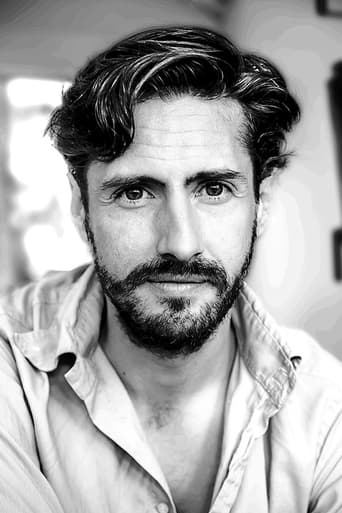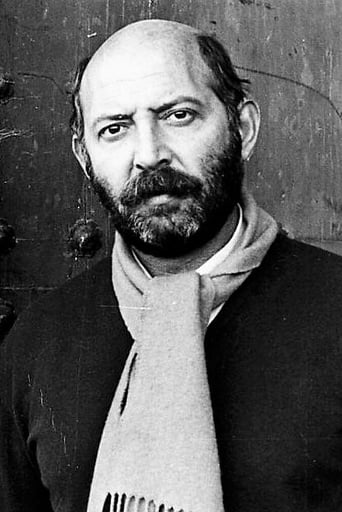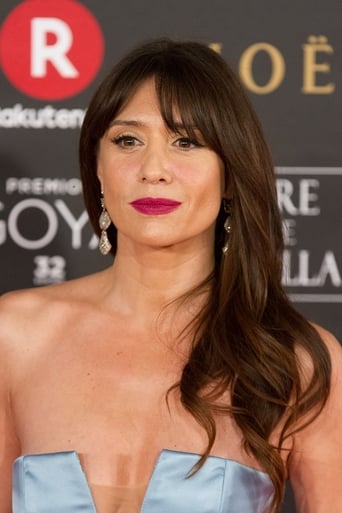Mjeteconer
Just perfect...
GurlyIamBeach
Instant Favorite.
FeistyUpper
If you don't like this, we can't be friends.
Marva
It is an exhilarating, distressing, funny and profound film, with one of the more memorable film scores in years,
ma-cortes
Dramatic picture about the consequences of Spanish civil war , Maquis or Republican guerrillas , the anti-Franco resistance and many other things . "Broken Silence", adapted from a screenplay by the same director Montxo Armendáriz , being realized with academicism and general coldness ; adding a splendid , luxurious photography with juicy atmosphere . This slow-moving and intelligent picture is well set in Spain of the 40s . It happens in Winter, 1944 , a heavily wooded valley of the River Urrobi called Valle Arce . Lucía (Lucia Jimenez) at 21 returns to her small village in the Pamplona mountains to live with her uncle (Pepo Oliva) and aunt (Mercedes San Prieto) . She again meets Manuel (Juan Diego Botto), a young Blacksmith who helps "those in the mountain", the "maquis", these brave Guerrilleros go on battling for their ideas , even at the cost of their own existences . Then , a traitor informs about resistance fighters and Manuel is chased by Franco's Civil Guard (Joseba Apaolaza , Jordi Bosch) . Later on , he escapes to the mountain along with other members (Ramon Barea , Patxi Bisquert , among others) of guerrilla and Lucía uncovers the terror , vengeance , fear , treason and the broken silence.¨Silencio Roto¨ or ¨Broken silence¨ results to be other of the innumerable stories to deal with dramatic deeds regarding the Civil War background and Franco epoch . A familiar theme about the global horrors of a fratricide war , impossible to forget to our cinema .This interesting historical story is a passionate retelling and a touching as well as intense drama . Armendariz , also writes the script and filmed in his usual formal and stylistic scholarship , without leaving a trace the thought-provoking issues , in terms of dramatic and narrative excitement , including the reality of political repression , betrayal , accusation and political facts by that time . This is a Spanish average budget production and obtained enough success in the box-office . The main problem has to face "Silencio Roto", beyond not being able to avoid falling into the politic pamphlet is precisely derived from the coldness of its staging , which eventually become monotonous over two hours of footage . Because the story needs a vibration more real than the one offered in this slow-moving and sometimes boring film . But anyway, its is compensated with the great performances from main and support cast specially . Agreeable acting by starring couple who plays an enjoyable love story in which beautiful Lucía/Lucia Jimenez is attracted to a young iron-smith Manuel/Juan Diego Botto , because of his smile and the bravery . Secondary players are frankly excellent ; as a magnificent support cast of known and prestigious players , such as María Botto , Rubén Ochandiano , María Vázquez , Patxi Bisquert , Pepo Oliva , Jordi Bosch and special mention to veterans as Ramón Barea , Alvaro De Luna , Mercedes San Pietro , Asunción Balaguer , Francisco Rabal's wife and , in addition , Manuel Lozano , the starring boy in ¨Secretos del Corazón¨ . Besides , a spotless pictorial cinematography by Guillermo Navarro , Guillermo Del Toro's ordinary cameraman , and a willingness , almost perfect of the elements of each shot , every sequence, every space . A colorful picture , including marvelous frames , being mostly filmed at Arrieta, Vizcaya , Lusarreta, Navarra, Saragüeta, and Villanueva de Arce, Navarra, Spain . Sensitive and emotive musical score by Pascal Gaigne . The picture achieved various prizes such as Butaca Awards 2001 Best Catalan Film Actress : Mercedes Sampietro , CEC Award Best Supporting Actress Mercedes Sampietro , Nantes Film Festival 2002 Won best director and Nominated Goya Best New Actor Rubén Ochandiano . Well directed film by Montxo Armendariz , including his own story and screenplay , who tried to create an agreeable flick plenty of sensitivity and sometimes violent confrontation between Maquis and Guardia Civil by tackling an evocative description about a particular period in Spain history . The motion picture perfectly produced by producers Puy Oria and Montxo Armendáriz was professionally directed by the latter , a very good Spanish movies director . Armendariz directed a series of award-winning movies firmly establishing him as one of the best Spanish filmmakers and an expert on literary adaptations . Montxo is a well recognized filmmaker both nationally and internationally, and in proof of it he won many awards in several Festivals . Montxo Armendáriz was born in Navarra, Pamplona , and his films are mostly set in this Spanish region . He is a nice writer and director, expert on dramas , being especially known for Tasio (1984) , 27 hours (1986) , Cartas a Alou (1990) , Secretos del Corazón (1997), (2001) Obaba (2005), No Tengas Miedo (2011) and this Silencio Roto or Broken silence .
Keith F. Hatcher
I cannot help thinking that sometimes the countryside in which a film is set is almost as important as the story-line of the film itself. This often happens with films by Montxo Armendáriz, who, not surprisingly, makes good use of his own native and beautiful Navarra. This is evidently the case with `Tasio' (qv) and `Secretos del Corazón' (qv), the latter film being without any doubt his masterpiece up till now.For `Silencio Roto', he moved across to the north-east of Pamplona, in the heavily wooded valley of the River Urrobi, otherwise known as the `Valle de Arce' - precisely because that is what most abounds in this tight little valley: `arces', maple trees. Coming down the valley from Urrobi along the narrow winding road following the tumbling sparkling river, after about 5 kilometres you have on the left Villanueva de Arce and Arrieta, and on the right Lusarreta and Saragüeta, four villages where this film was shot: old timbered houses with cabbage allotments and runner-beans, chickens running free, a few pigs, old barns covering old Fordson tractors, and balconies ablaze with peonies, amid dung heaps not very hidden behind the hedgerows, and the odd "borda" where you can get something to eat! Do not go on down beyond Uriz or Arce as all the rest has been flooded by a monstrosity called the Aoiz Dam (Itoiz), a savage crime against nature, a heneous crime against those lovely little villages which have been drowned in the name of progress........With `Silencio Roto' Armendáriz has carried out an ambition of his, which was to bring to life as realistically as possible life in the years following the Civil War, and specifically that of the `maquis'. The `maquis' were groups of men - a few women - who hid in the hills after the war finished, to continue their struggle against the fascist regime of Franco. These groups, which might be called `guerillas' (in Spanish `guerilleros'), lasted for years in the mountains of Asturias, Euskadi (Basque Country) and Navarra, principally, with a few in places like León and Cantabria.
Perhaps the best-known example for English readers on the hill-fighters in Spain is Hemingway's novel `For Whom The Bells Toll' which has also been made into film, but of course has no relation nor comparison with Almendáriz's film: Almendáriz is Navarran to the core and has nurtured his local folklore and traditions since he was born.Thus authenticity would seem to be the key to the making of this film.Frankly I am usually more than fed up with films here in Spain resorting to the Franco years as a kind of scapegoat, as I have said elsewhere on IMDb. I say that more or less in the same way I would say I get more than fed up with the eternal John Wayne being the `goodie', or with Harrison Ford playing himself in just about every film he has made.However, with Armendáriz you have to take into consideration the artesan or craftsman at work: he is not there just to splash a story on screen so that you lap it up the same as you might with almost any frightful TV series or any of those ghastly Hugh Grant/Richard Gere/............... (I leave the space for you) tragic dollar-makers. There are a few European directors eminently capable of getting down to the innermost parts of the souls of people - Ermanno Olmi, Jaco van Dormael, Bertrand Tavernier, Víctor Érice and Mario Camus come to mind - and Armendáriz is one of that very select group.Wonderful photography and acceptable music score accompany some good interpretations. Mercedes Sampietro as ever just wonderful, as also the veteran Álvaro de Luna, and it was nice to see Asunción Balaguer, now widower of our one and only Paco Rabal. I was disappointed not to see more of Andoni Erburu after his astounding playing in `Secretos del Corazón'. The lead actors, Juan Diego Botto as Manuel and Lucía Jiménez as Lucía (!!) were fine, especially Ms Jiménez who had to take the brunt of almost the whole run-time of the film on her shoulders, but did so with more than acceptable naturalness. There are also other actors with genuine Navarran surnames - Erro, Goñi - who gave us a few authentic accents!I always mean to find some film-director and ask him: where the hell did you find that old bus/motor-cycle/aeroplane etc. for the film? You watch a film set in the 1930s, 1940s, 1950s, but made only the other day, and you marvel at these wonderful old vehicles or even genuine old Singer sewing-machines. But here, as in `Secretos del Corazón', Armendáriz knew where to find these lovely old treasures. The bus that pulls into the village at the beginning of the film is a wooden-bodywork, driver-behind-the-engine that might well have been running on solid tyres! In fact the film uses objects from the ethnological museum belonging to Julio Baroja, an eminent writer on philosophical, sociological and ethnological matters.Not so far away you can visit the ethnological museum in Arteta, to the west of Pamplona. Painstakingly run by José Ulibarrena Arellano, a vast higgledy-piggledy collection of household and farm equipment - from old toys and kettles to hand-saws and drills and horseshoes. Even the house is a museum in itself, dating from the 16th/17th Century.Just in case you are wondering: all this - and films by Armendáriz in general - is little more than an hour away by car from where I am now, and, it should be said, here in the Rioja we have a small city which years ago was the capital of the ancient Kingdom of Navarra. Obviously, then, geographically and most definitely as a clear indication of neighbourliness, anything and everything to do with Navarra is of great interest to me. It is simply a question of Ramiro Sánchez and Doña Urraca and people like that, you see?Seriously now, take pains to study this film closely. Whereas it may fall short of the poetic exquisiteness of `Secretos del Corazón', it is still worth the attention of intelligent viewers who would wish to grasp historical and cultural aspects of `old' Europe, well, Spain in this case.
jotix100
Montxo Armendariz film about an episode of the Spanish history is interesting, but at the same time it is very confusing, as proven by the samples heard after the projection at the recent film cycle at the Walter Reade theater in New York.Most of us in the audience obviously knew about some of the history that is shown in the film, but not enough as the first person, Ossanser, from Valencia, Spain who wrote the first commentary on the opening page . That is why at times we are lost in trying to think how was it possible to see the rebels fighting when both the Civil War and World War II were over.The film was interesting to watch, but there are a lot of loose ends that are not resolved, as far as we are concerned.Loved the women in this film the best. Lucia Jimenez, Mercedes Sanpietro and Maria Botto were very restrained. It's about the best quality I find with Mr. Armendariz's films, in contrast with some other Spanish directors, he's the captain of the ship and nothing seems to be out of place, contrary to other 'geniuses' from Spain who sometimes let the cast get away with murder.One can only wish the best to this director in future films.
BITELCHUS
I recently noted that one of the most forgotten men groups in the history about the terrible spanish civil war (1936-1939) are the "maquis". They were the fighters for freedom that resist in the mountains after the General Franco´s victory. They fought till nearly 1950, in several fast hits... they only wanted the liberty for the spanish people, then in the hands of the fascist ideology. But in more than 25 years of pacific democracy and progress, and a lot of movies about that war... very poor was the number of them that spoke about "maquis". Montxo Armendáriz, director of the 1998 Best Foreign Language Academy Award nominee "Secrets from the heart" has done it. It is a truly movie. With very good performances, specially Mercedes Sampietro and Lucía Jimenez, and a good screenplay he has done a spectacular movie for the heart. For the remenbrances. For the people who didn´t know nothing about this phenomenon, and for those that lived it... A song to the liberty... not only a movie.




